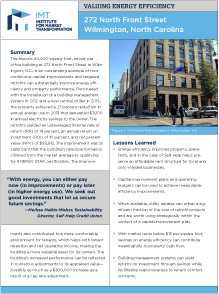Valuing Energy Efficiency, a new package of case studies from the Institute for Market Transformation (IMT), examines the financial outlay and impact of energy efficient retrofits on a range of building types across the U.S., to show that building owners don’t need a billion dollar budget nor a large floorplate to reap all the benefits of energy efficiency. The six buildings presented in this series—including affordable multifamily housing, Class B office buildings, small manufacturing plants, and an old university laboratory—represent the true depth of existing buildings across America.
Each of the buildings featured in this series was chosen because it is located outside of prime market areas such as central business districts, trendy neighborhoods, and major redevelopment zones. As a whole, the case studies show that with careful attention to financial parameters, significant energy and cost savings can be achieved in a diverse range of building types without requiring a raise in rent or product prices to justify the retrofit expenditure. While some outside technical assistance was required to supplement internal resources and expenses, these building owners accomplished most of their upgrades and adjustments as part of the ongoing improvements to their buildings and their businesses. Their ingenuity is something from which many buildings owners can learn.
In this case study:
Built in 1906, Self-Help’s downtown Wilmington property shows that an older building, likely designed without efficiency in mind, can improve its energy performance through retrofits while making the building more affordable for its retail, small business, and non-profit tenants. Self-Help installed a building management system and a new chiller to achieve 21 percent energy cost savings and 13 percent water cost savings, lowering its site energy use intensity (EUI) by 28 percent. Annual energy savings of $11,100 have led to a more productive asset and may result in a lower cap rate and increased property value.
Access the full series:
- Laboratory Space: University of Minnesota, Minneapolis, MN. The retro-commissioning of the University of Minnesota’s Biological Sciences laboratory highlights the opportunity to invest in energy efficiency in the institutional sector, where optimizing an existing building’s energy performance can extend its useful life.
- Manufacturing Space: Tusco Display, Tuscarawas County, OH. The custom fabrication company Tusco Display has used energy efficiency in its manufacturing and commercial spaces as a strategy to lower costs, improve productivity, and gain a cost advantage in a challenging market with many competitors.
- Multifamily Housing: CheckMate Realty & Development, Chicago, IL. CheckMate Realty, a Chicago property owner dedicated to providing high-quality affordable housing, worked with Elevate Energy and Community Investment Corporation to retrofit a 31-unit naturally affordable multifamily building in South Shore Chicago, originally built in 1928.
- Multifamily Housing: Continental Plaza, Chicago, IL. Continental Plaza is a 1950s building that provides 164 affordable, one-bedroom apartments for seniors. To fulfill the U.S. Department of Energy’s Better Buildings Challenge, Hispanic Housing Development Corporation formed Affordable Community Energy, a unique mission-driven energy services company model to pursuing retrofits that cut its energy bill by 23 percent and its water bill by nearly 5 percent, while adding hundreds of thousands of dollars to the property’s value.
- Office Space: Self-Help, Greensboro, NC. Through energy efficiency retrofits, Self-Help uses operational expense savings to help preserve affordable rents for 21 non-profit tenants in a mid-rise office building in Greensboro.
